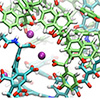| Oct 23, 2024 |
|
(Nanowerk News) Nanoplastics, emerging as persistent environmental pollutants, pose significant threats due to their durability and wide distribution in water bodies. Their interactions with natural organic matter are critical, influencing pollutant retention, microbial processes, and the carbon cycle. However, the structural complexity of both aged nanoplastics and natural organic materials complicates their study. This complexity necessitates advanced research to clarify how these interactions contribute to ecological risks.
|
|
Researchers from Northwest A&F University and South China Agricultural University have published a study in Eco-Environment & Health (“Molecular modeling to elucidate the dynamic interaction process and aggregation mechanism between natural organic matters and nanoplastics”), that explores the interaction between nanoplastics and natural organic matter through molecular modeling.
|
|
The study uses molecular dynamics simulations and density functional theory (DFT) to investigate the aggregation mechanisms of polyethylene, polyvinyl chloride, and polystyrene nanoplastics in both their pristine and aged states.
|
|
The study reveals that pristine nanoplastics aggregate through hydrophobic interactions, forming compact clusters that attract natural organic matter. Aged nanoplastics, having undergone chemical changes such as oxidation, engage in more complex interactions, including cation bridging with Ca²⁺ ions, hydrogen bonding, and electrostatic forces. These findings suggest that the aging process increases the reactivity of nanoplastics, affecting their behavior in aquatic systems and potentially altering ecosystem stability.
|
|
Dr. Hanzhong Jia, the lead researcher, emphasized the importance of these findings, stating, “Our study sheds light on the molecular-level processes that drive nanoplastic aggregation in aquatic environments. Understanding these mechanisms is crucial for predicting their behavior and assessing the long-term environmental impacts of nanoplastics.”
|
|
The research provides valuable insights for environmental scientists and policymakers. A deeper understanding of nanoplastic interactions with organic matter could guide efforts to combat plastic pollution, refine ecological risk assessments, and develop new water purification technologies aimed at removing these contaminants.
|

